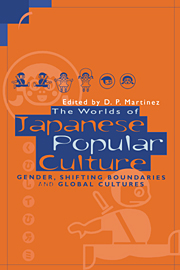Chapter 6 - Japanese Women's Magazines
The language of aspiration
Published online by Cambridge University Press: 22 September 2009
Summary
Introduction
A strong unifying theme that runs through Japanese women's magazines is the prescriptive approach which they adopt towards their readers. This is much more striking than the attention to detail in features which Shimanaka Yukio (n.d.) notes, or the descriptive and pedestrian list of characteristics common to magazines in general which Kawai Ryosuke provides (1987). In this chapter special attention will be paid to linguistic questions, the frequency of certain expressions, keywords, and so forth. It is hoped that by examining these aspects of magazines for young women light can be shed on the contemporary lifestyles and aspirations of these women in Japan.
Women's magazines
Japanese women's magazines have changed greatly in character during this century. According to Shimanaka (n.d.) the first of six distinct periods, which spanned the years from 1900 to the end of the Second World War, was represented by monthly magazines such as Fujin Gahô (Illustrated Women's Gazette 1905), Fujin Kôron (Women's Opinion 1916), Shufu (Housewife), and Shufu no Tomo (Housewife's Friend 1917), Fujin Kurabu (Women's Club 1920) and Sôen (Jardin de Mode 1926). The principal policy common to these five magazines was “enlightened educationalism”, expressed through essays on subjects such as “women's liberation”, “liberalism” and the “attainment of female suffrage”.
The second period extended only from 1946 to the first half of the 1950s, when Japan experienced rapid economic recovery after defeat in the Second World War, partly due to the Korean War.
- Type
- Chapter
- Information
- The Worlds of Japanese Popular CultureGender, Shifting Boundaries and Global Cultures, pp. 110 - 132Publisher: Cambridge University PressPrint publication year: 1998
- 10
- Cited by



